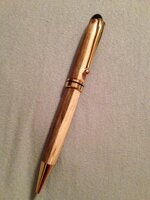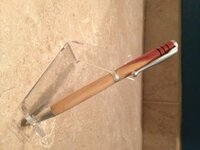I recommend using paper towels or something else that will tear away easily.
Do not use cloths or rags on your spinning stuff. The rag can wrap around the spinning bit and pull your finger in with it.
Here is my process
I apply CA to desired thickness depends on if I need to build up to desired thickness to cover up an overturning error or fill a void. Typically I apply 1 or 2 applications of thin followed by 6-8 applications of medium with a shot of accelerator between medium applications. I'm going to try the foam especially if it will save me on CA. Currently using 2-3 drops on a paper towel applicatior per application.
Once I have the thickness correct (measuring here I shoot for about .001 - .005 overbuilt) I start sanding.
I dry sand with 320 just until the surface is flat and the shine has been knocked off. (this is why dry sanding here) If you see shiny strands or lines, then you still have ridges and the surface is not flat. Sometimes I need to back off to 220 if the ridges are too big (too heavy a hand on the application or lots of CA from the build-up.) Don't forget to measure where the components will meet the blank after knocking the ridges off. You may need to add more CA or sand a bit more off to get the thickness right. It's a game of give and take to get the thickness correct, at this point the diameter of the blank should match the mating part.
Once the surface is flat and the right thickness, the remaining job is to progressively remove scratches (polish). I wet sand through 600 stopping between grits to sand along the axis of the pen and wipe off the previous grit. Don't overdo it here, you're just removing scratches not removing material. Some people do this by hand without the lathe running.
Next I use maquire's scratch X 2 (It's what I have on hand for getting scratches out of the car finish and works well) I have also used brasso with good results. I just us a drop or 2 on a paper towel. If I'm going for a satin finish, I'm done.
For a glossier finish, I switch to buffing along the axis of the pen. IMHO and personal preference buffing achieves a superior shine, is much faster, and way cheaper than the MM pads. Buffing wheels and compounds were $3-4 each at sears (I spent less than $25 for three wheels and compound which will last for years) I use a shopsmith so I can mount 2 wheels at once. There are tutorials for making a buffing mandrel similar to the beall triple buff for your lathe as well. There are also some nice tutorial videos at exotic blanks.
http://www.exoticblanks.com/index.php?option=com_content&view=category&layout=blog&id=37&Itemid=66 How to #8 - Buffing
Some people only use the tripoli (brown) and white compounds. I added the blue as it is a true polishing compound is less greasy than the red and has no cutting action at all.
How I buff. I made a mandrel like the one in Ed's video to hold the blank against the buffing wheels.
I start with Tripoli (brown compound) on a sewn cotton wheel (stiffer than the flannel and provides some cutting action)
first use a cutting action pushing against the rotation of the wheel (usually the top of the wheel pushing away from you) this gets the last of the visible sanding scratches off of the pen. Makes sure all sides of the pen run against the buff. Don't push hard let the buffing wheel do the work.
Then use a coloring action moving the pen with the rotation of the wheel (the bottom of the wheel again pushing away from you)
Next use White Diamond (white compound) on a loose flannel wheel using a coloring action
Finally use the Blue Plastic compound on a loose flannel wheel using a coloring action.
Uses different wheels for the different compounds, apply compound sparingly, a little goes along way.
Buffing takes maybe 3 minutes including changing over the wheels.
This is how I do it and I like the results I'm getting YMMV.



